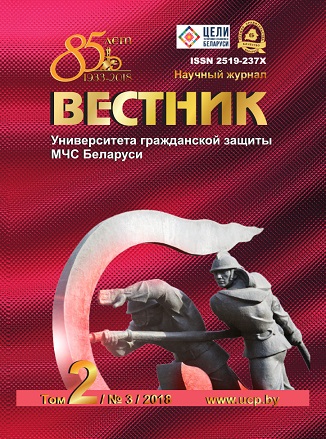Исследование влияния толщины слоя гранулированного пеностекла на горение жидкостей ряда алканов
DOI:
https://doi.org/10.33408/2519-237X.2018.2-3.320Ключевые слова:
массовая скорость выгорания, алканы, пентан, гептан, октан, декан, додекан, пожары в резервуарах, гранулированное пеностекло, гель, повторное воспламенениеАннотация
Показана возможность прекращения горения жидких углеводородов ряда алканов за счет последовательного нанесения на поверхность жидкости легкого носителя (пеностекла) и гелеобразующего состава. Экспериментально определено влияние толщины слоя пеностекла на массовую скорость выгорания жидких гомологов ряда алканов: пентана, гептана, октана, декана и додекана. Установлено, что массовая скорость выгорания алканов уменьшается с ростом толщины слоя пеностекла. Отмечен эффект прекращения горения высококипящих алканов (декан, додекан) при достижении толщины слоя пеностекла 8 и 6 см; для октана необходим слой пеностекла 10 см. Низкокипящие алканы (пентан, гептан) не гаснут при толщине слоя пеностекла 12 см. Нанесение на пеностекло геля в указанных условиях ускоряет тушение и гарантирует невозможность повторного воспламенения.
Библиографические ссылки
Campbell R. Fires at Outside Storage Tanks. Report National fire protection association: August 2014, available at: https://www.nfpa.org/News-and-Research/Fire-statistics-and-reports (accessed: June 28, 2018).
Hylton J.G. U.S. Fire Department Profile. Report National fire protection association: April 2017. 39 p, available at: https://www.nfpa.org/-/media/Files/News-and-Research/Fire-statistics/Fire-service/osfdprofile.pdf (accessed: June 28, 2018).
Borovikov V. Gasinnja pozhezh u rezervuarah dlja zberigannja nafty i naftoproduktiv [Extinguishing fires in tanks with oil and oil products]. Pozhezhna ta tehnogenna bezpeka. 2015. No. 11 (26). Pp. 28–29. (ua)
General Foam Information. U.S. Сhemguard association. August 2017. 6 p, available at: http://www.chemguard.com/about-us/documents-library/foam-info/general.htm (accessed: June 28, 2018).
Fire Fighting Foam Principles and Ethanol-Blended Fuel. 2016. 20 p., available at: http://www.ncdoi.com/OSFM/RPD/PT/Documents/Coursework/Ethanol/Module5_ParticipantManuals.pdf (accessed: June 28, 2018).
Statut dij u nadzvychajnyh sytuacijah organiv upravlinnja ta pidrozdiliv Operatyvno-rjatuval'noi' sluzhby [Statute of actions in emergencies of the authorities and units of the Rescue Service]. Kyi'v: MNS Ukrai'ny. 2012. 42 p. (ua)
Volkov R.S., Voytkov I.S., Vysokomornaya O.I. Osobennosti tusheniya zhidkikh topliv i organicheskikh zhidkostey raspylennoy vodoy [Features of fire extinguishing of liquid fuels and organic liquids by sprayed water]. Pozharovzryvobezopasnost'. 2016. Vol. 25, No. 4. Pp. 68 –75. (rus)
Bocharov V.V. Ispol'zovanie perftorirovannykh PAV v penoobrazovatelyakh – «vtoroe prishestvie». Galogenorganika s naikhudshim stsenariem razvitiya dlya obitateley zemli [The use of perfluorinated surfactants in blowing agents is the second coming. Halogenorganika with the worst development scenario for the inhabitants of the earth]. Pozharovzryvobezopasnost'. 2013. Vol. 22, No. 10. Pp. 75–82. (rus)
Seam J. Fire fighting foams with perfluorechemicals - Environmental revive. 2013. 75 р, available at: http://www.hemmingfire.com/news/get_file.php3/id/287/file/Seow_WA-DEC_PFCs_Firefighting_Foam_final_version_7June2013.pdf (accessed: June 28, 2018).
Amankeldi F., Ospanova Z., Musabekov K. Composite Foaming Agents on the Basis of High-Molecular Natural Surfactants. Colloids Interfaces. 2018. Vol. 2, No. 4. Pp. 2–8.
Patino J.M., Sanchez С.С., Niсo M.R. Implications of interfacial characteristics of food foaming agents in foam formulations. Adv. Colloid Interface Sci. 2008. Vol. 140, No. 2. Pp. 95–113.
Borisov P.F., Rosokha V.E., Abramov Yu.A., Kireev A.A., Babenko A.V. Sposob tusheniya pozhara i sostav dlya ego osushchestvleniya [Fire extinguishing method and composition for its implementation]: patent RU No. 2264242, IPC A 62 C 5/033. Owner: Academy of Fire Safety of Ukraine. Publ. November 20, 2005. (rus)
Popov M., Zakrevskaya M.L., Vaganov V. Performance of Lightweight Concrete based on Granulated Foamglass. Sci. Eng. 2017. Vol. 96, No. 1. Pp. 1–7.
Limbachiya M., Meddah M.S., Fotiadou M.S. Performance of granulated foam glass concrete. Construction and Building Materials. 2011. Vol. 28, No. 1. Pp. 759–768.
Tarakhno O.V., Tregubov D.G., Zhernokl'ov K.V. et al. Teorіya rozvitku ta pripinennya gorіnnya. Praktikum [Theory of Development and Extinguishing of Combustion]: workshop in 2 parts. Harkіv: NUCZU, 2010. 822 p., available at: http://repositsc.nuczu.edu.ua/handle/123456789/3231 (accessed: June 28, 2018). (ua)
Dadashov I.F. Eksperimental'noe issledovanie izoliruyushchikh svoystv geleobraznykh sloev po otnosheniyu k param organicheskikh toksichnykh zhidkostey [Experimental study of the insulating properties of gel-like layers in relation to vapors of organic toxic fluids]. Problemy cyvil'nogo zahystu. 2017. Iss. 25. Pp. 22–27. (rus)
Dadashov I.F. Eksperimental'noe issledovanie vliyaniya tolshchiny sloya granulirovannogo penostekla na gorenie organicheskikh zhidkostey [Experimental research the influence of thickness of the layer of a granulated film glow on the burning of organic liquids]. Problemy pozharnoy bezopasnosti. 2018. Iss. 43. Pp. 38–44. (rus)
Опубликован
Как цитировать
Лицензия
Все права защищены (c) 2018 Дадашов И.Ф.
CC «Attribution-NonCommercial» («Атрибуция — Некоммерческое использование») 4.0




















